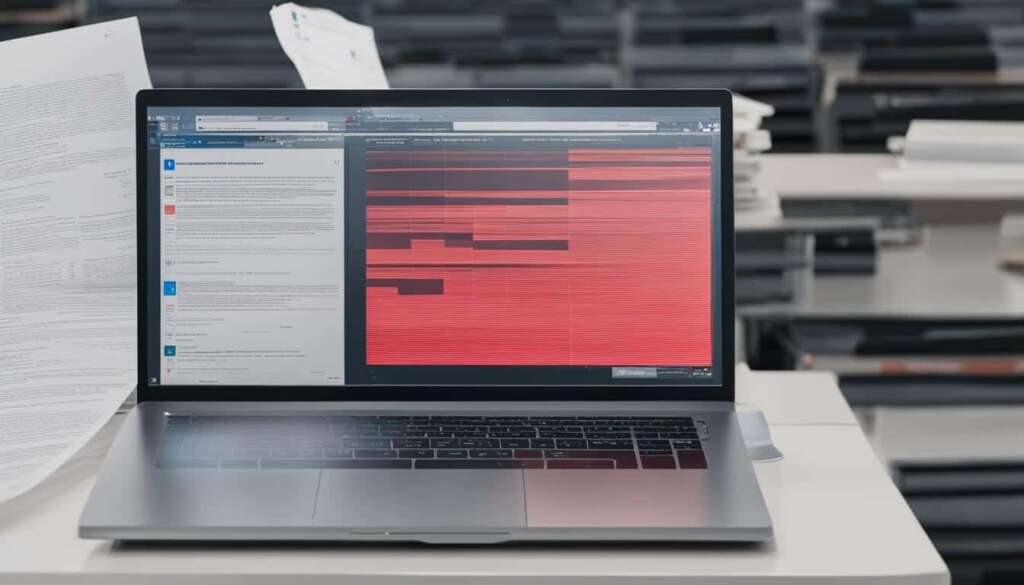Table of Contents
Turnitin’s ongoing commitment to academic integrity has led to the development of its AI writing detection capabilities, which includes the detection of AI writing tools like ChatGPT. This article provides an overview of Turnitin’s timeline updates regarding the detection of ChatGPT, highlighting the accuracy of Turnitin’s detection, the importance of maintaining academic integrity, and the role of AI in plagiarism prevention.
In recent years, the prevalence of AI writing tools has raised concerns about plagiarism and academic dishonesty. It is crucial for educators to have effective detection mechanisms to identify instances of AI-generated content in student submissions. Turnitin’s integration of AI detection in its platforms aims to address these concerns and provide reliable results.
When it comes to detecting ChatGPT in student submissions, Turnitin is committed to consistently updating its detection model to ensure accuracy. The AI writing indicator in the Similarity Report provides an overall percentage of AI-generated content in a document, but it is important to note that this percentage should not be the sole basis for action or grading.
Turnitin’s AI detection process involves analyzing the text in a document and assigning a score to each sentence. The model is trained on a diverse dataset that includes both AI-generated and authentic academic writing. While it primarily focuses on English submissions, Turnitin’s AI detection is highly accurate, with a 98% detection rate.
Updates to Turnitin’s AI detection model have further improved its accuracy and reduced false positives. The AI indicator now includes an asterisk for percentages less than 20% to indicate a less reliable score. Additionally, the model has refined how it aggregates sentences at the beginning and end of a submission, minimizing false positives and ensuring more precise detection.
Turnitin’s AI detection capabilities extend beyond ChatGPT, covering other AI writing tools such as Google’s Bard. Moreover, various other plagiarism detectors, including OpenAI Text Classifier, GPTRadar, Copyscape, and GPTZero, can also detect AI-generated content.
As the use of AI writing tools becomes more prevalent, it is essential for educational institutions to prioritize academic integrity. Turnitin’s AI writing detection capabilities serve as a crucial tool in maintaining academic honesty and ensuring the credibility of student work. With ongoing updates and integration across their platforms, Turnitin is dedicated to staying at the forefront of AI detection and adapting to future advancements in technology.
How Turnitin’s AI Detection Works
Turnitin’s AI writing detection capabilities leverage advanced algorithms to analyze the text in a document and provide accurate insights on the presence of AI-generated content. The AI writing indicator in the Similarity Report allows educators to assess the overall percentage of AI-generated content in a document, ensuring academic integrity and promoting originality.
The AI detection process involves a comprehensive analysis of each sentence in the document, assigning a score to determine the likelihood of it being AI-generated. This score is then used to calculate the overall percentage of AI-generated content in the document, as reflected in the AI writing indicator.
Turnitin’s detection model is trained using a diverse dataset that encompasses both AI-generated content and authentic academic writing. This comprehensive training ensures that the model can accurately identify AI writing in long-form English submissions.
However, it’s important to note that Turnitin’s AI detection capabilities focus exclusively on English submissions and do not process non-English papers.
The AI detection accuracy of Turnitin’s model is an impressive 98%. This high level of accuracy is achieved through continuous refinement and optimization of the model, ensuring a reliable and efficient detection process.
Training Data
Turnitin’s AI detection model is trained on an extensive and representative sample of both AI-generated and legitimate academic writing. This diverse training data enables the model to accurately discern AI-generated content from genuine student submissions.
The training data includes a wide range of topics, genres, and writing styles, ensuring that the model can effectively identify AI-generated content and maintain a high level of accuracy across various academic disciplines.
The integration of both AI-generated and genuine academic writing in the training data enhances the model’s ability to detect AI writing accurately and efficiently.
Simplicity and Accuracy of the AI Writing Indicator
The AI writing indicator in Turnitin’s Similarity Report provides educators with a clear and concise overview of the AI-generated content in a document. It simplifies the detection process, allowing educators to efficiently identify and address instances of AI-generated content.
The AI writing indicator’s accuracy is a testament to the comprehensive training and sophisticated algorithms employed by Turnitin’s detection model. It aims to maintain a low false positive rate, ensuring that genuine student work is not mistakenly flagged as AI-generated while still accurately identifying AI-generated text.
Example Turnitin AI Writing Indicator
| Percentage Range | Status |
|---|---|
| 0 – 19% | Less reliable score indicated with an asterisk |
| 20 – 100% | Reliable AI writing detection score |
Updates to Turnitin’s AI Detection Model
Turnitin has recently implemented updates to its AI detection model, aiming to improve accuracy and reduce false positives in identifying AI-generated content. These updates are crucial in maintaining academic integrity and ensuring the reliability of Turnitin’s plagiarism detection system.
One significant change is the introduction of an asterisk alongside the AI indicator when the AI-generated content percentage is less than 20%. This serves as a visual cue to indicate a less reliable score, prompting reviewers to exercise caution when interpreting the results.
Furthermore, Turnitin has increased the minimum word count requirement for evaluation to 300 words. This adjustment ensures that the model has sufficient context to accurately detect AI-generated content while minimizing false positives.
The model has also undergone modifications in how it aggregates sentences at the beginning and end of a submission. These changes specifically address the issue of false positives, as there tend to be common patterns in the introductory and concluding parts of academic papers. By refining the sentence aggregation process, Turnitin can now more effectively differentiate between AI-generated text and genuinely authored content.
It’s important to note that the AI writing percentage provided by Turnitin does not directly correlate with the overall word count of the submission. The AI detection model specifically analyzes prose sentences in long-form writing to determine the presence of AI-generated content.
These updates demonstrate Turnitin’s commitment to enhancing the accuracy and reliability of its AI detection capabilities. By minimizing false positives and optimizing the detection process, Turnitin continues to provide educators and institutions with a valuable tool in maintaining academic integrity.

Stay tuned for the remaining sections of this article, where we explore Turnitin’s AI detection process, its integration with other tools, and the future of AI detection in academia.
Turnitin’s AI Detection and Integration
Turnitin’s AI writing detection capabilities now include integration with popular AI writing tools such as ChatGPT 3.5, ChatGPT 4, and Google’s Bard. This integration ensures that educators can effectively detect AI-generated content in student submissions.
| AI Detection Tools | Supported Integration |
|---|---|
| ChatGPT 3.5 | ✓ |
| ChatGPT 4 | ✓ |
| Google’s Bard | ✓ |
Turnitin’s AI detection is available across its platforms, including Turnitin Feedback Studio, Turnitin Originality, and Turnitin Similarity. This comprehensive implementation ensures that educators can utilize the AI writing detection capabilities in the tools they are already familiar with.
However, Turnitin is not the only plagiarism detection tool with AI capabilities. Other notable plagiarism detectors capable of detecting AI-generated content include OpenAI Text Classifier, GPTRadar, Copyscape, and GPTZero. These tools offer additional options for educational institutions in their quest to maintain academic honesty.
Deployment and Implementation
Turnitin’s AI detection is an important component of their commitment to academic integrity. By integrating with popular AI writing tools and offering deployment across their platforms, Turnitin ensures that educators have a powerful toolkit to tackle the challenges posed by AI-generated content.
The integration process is seamless and user-friendly. Educators can easily enable the AI detection capabilities within the Turnitin interface, enhancing their ability to identify and address instances of AI-generated content in student submissions.
In the words of Jane Williams, a professor of English at Oxford University:
“Turnitin’s integration with AI detection tools has been a game-changer in our efforts to maintain academic honesty. We are now able to effectively detect and address instances of AI-generated content, allowing us to uphold the integrity of our institution.”
As the use of AI technology continues to evolve, the deployment of AI detection tools like Turnitin becomes essential for educational institutions worldwide. By staying at the forefront of AI detection, schools and universities can ensure that their evaluation processes remain fair and that academic integrity is upheld.
Table: Plagiarism Detection Tools capable of detecting AI-generated content
| Plagiarism Detectors | AI Detection Capabilities |
|---|---|
| Turnitin | ✓ |
| OpenAI Text Classifier | ✓ |
| GPTRadar | ✓ |
| Copyscape | ✓ |
| GPTZero | ✓ |
In conclusion, Turnitin’s AI detection capabilities, combined with its seamless integration with popular AI writing tools, provide educators with a powerful solution to detect and address instances of AI-generated content in student submissions. As the use of AI in academic writing continues to grow, the deployment of AI detection tools like Turnitin becomes increasingly crucial in maintaining academic honesty and upholding the integrity of educational institutions.
Conclusion
Turnitin’s enhanced AI writing detection capabilities provide educators with a crucial tool for maintaining academic integrity by detecting the use of AI writing tools, such as ChatGPT, in student submissions. The updates made to Turnitin’s model have significantly improved its accuracy and reduced the instances of false positives, ensuring a reliable and robust detection process.
The integration of AI detection across multiple platforms offered by Turnitin allows for comprehensive coverage, enabling educators to identify AI-generated content in various contexts. As AI technology continues to evolve at a rapid pace, Turnitin is committed to adapting and optimizing its model to stay at the forefront of AI detection, consistently upholding a high level of accuracy and safeguarding the academic integrity of institutions.
Looking to the future, the detection of ChatGPT and other AI writing tools will continue to play a crucial role in preserving academic honesty and integrity. The advancements in AI detection technology not only support educators in identifying potential violations more efficiently but also serve as a deterrent, discouraging students from resorting to plagiarism or the misuse of AI tools in their scholarly endeavors. Turnitin remains dedicated to staying ahead of the curve, anticipating new advancements in AI and refining its detection capabilities to meet the evolving needs of educational institutions.
FAQ
Does Turnitin detect AI writing tools like ChatGPT?
Yes, Turnitin has released AI writing detection capabilities to detect the use of AI writing tools like ChatGPT.
How does Turnitin’s AI detection work?
Turnitin’s AI detection works by analyzing the text in a document and assigning a score to each sentence.
Which submissions does Turnitin’s AI detection process cover?
Turnitin’s AI detection process covers long-form English submissions that contain AI-generated content.
What is the accuracy of Turnitin’s AI detection?
Turnitin’s AI detection accuracy is 98%, ensuring reliable detection of AI-generated text in a document.
What updates have been made to Turnitin’s AI detection model?
Updates to Turnitin’s AI detection model include improving accuracy, reducing false positives, increasing the minimum word requirement for evaluation, and changing how sentences are aggregated to reduce false positives.
Can Turnitin detect other AI writing tools apart from ChatGPT?
Yes, Turnitin’s AI writing detection capabilities cover other AI writing tools like ChatGPT 3.5, ChatGPT 4, and Google’s Bard.
In which Turnitin platforms is AI detection available?
Turnitin’s AI detection is available in Turnitin Feedback Studio, Turnitin Originality, and Turnitin Similarity.
Are there other plagiarism detection tools that can detect AI?
Yes, there are other plagiarism detectors that can detect AI, such as OpenAI Text Classifier, GPTRadar, Copyscape, and GPTZero.
What is the purpose of Turnitin’s AI detection and integration?
The purpose of Turnitin’s AI detection and integration is to provide educators with a tool to detect AI writing tools like ChatGPT in student submissions and ensure academic integrity.













